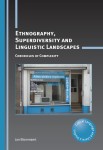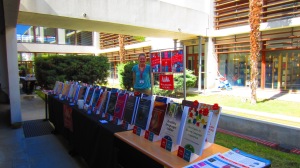We recently published English Learners’ Access to Postsecondary Education by Yasuko Kanno. In this post the author takes us behind the scenes of the research presented in her book.
 The hallmark of canonical ethnography, as Clifford Geertz once opined, is “being there”: You immerse yourself in a far-away place for months, even years, in order to document the cultural life of a group. But what if you are a full-time faculty member at a university with all the usual obligations of teaching and service? What if you also have a young child at home? Disappearing from the face of the earth to focus entirely on one’s ethnographic fieldwork doesn’t exactly fit into the reality of a working-parent academic. We need to be “here” teaching our classes, attending committee meetings, feeding our children while also trying to spend as much time as possible “being there.” It is under those conditions that I conducted my fieldwork for English Learners’ Access to Postsecondary Education.
The hallmark of canonical ethnography, as Clifford Geertz once opined, is “being there”: You immerse yourself in a far-away place for months, even years, in order to document the cultural life of a group. But what if you are a full-time faculty member at a university with all the usual obligations of teaching and service? What if you also have a young child at home? Disappearing from the face of the earth to focus entirely on one’s ethnographic fieldwork doesn’t exactly fit into the reality of a working-parent academic. We need to be “here” teaching our classes, attending committee meetings, feeding our children while also trying to spend as much time as possible “being there.” It is under those conditions that I conducted my fieldwork for English Learners’ Access to Postsecondary Education.
I must say that the “balance” part of the (field)work-life balance went out of the window as soon as fieldwork began. For one thing, high schools in the United States start early. At Brighton High School (pseudonym), the site of this ethnography, the first class started at 7:46 am. To make it to the first class for an observation, I would wake up around 5:45 am, pack a lunch box for my eight-year-old, feed him breakfast, get ready myself, and leave home by 7am. Then, a typical fieldwork day would look like this:
7:35 am: Check in at the security desk at Brighton to get a visitor’s badge
7:46 – 9:05 am: Observe Alexandra in her geometry class
9:10 – 10:29 am: Dash to another room to make it to Carlo’s American Literature class—only to find him absent that day (once again!). I observe the class anyway.
10:34 am: Walk to the other end of the school building to Ken’s study hall classroom, pick him up, and we walk together to the library for an interview.
11:15 am: Finish the interview. I stay in the library and add to my fieldnotes before I go home.
I made it a rule never to leave the school premises for the day until I finished augmenting my fieldnotes because I knew that as soon as I left the field site, my second and third shifts as a faculty member and as a mom were waiting for me. When my fieldwork ran late in the afternoon, I would sometime arrive at my son’s school just barely before the afterschool care ended. I would then pick him up, drive home, make dinner, and then head out again for his soccer practice. While waiting, I might read an article for my next class—or if I was truly desperate, grade some papers. At night, after my son went to bed, I would finish up the outstanding emails for the day, noticing that other mom colleagues of mine with young children were also emailing after 11 pm.
But is an ethnography produced by the “new me” who has so many other responsibilities inherently worse than work by “PhD student me” who had the luxury of devoting weeks at a time to fieldwork? The answer is an emphatic no. For one thing, I am now a far more skilled and experienced ethnographer. I can detect, much faster and with far more clarity, how emerging patterns fit into a developing narrative and subsequently adjust my data collection to confirm or deny these initial assertions. For example, I was able to notice, early on, that high-level academic courses such as honors and advanced placement (AP) courses were essentially inaccessible to my participants because they were ELs. My early detection of this pattern then led me to observe honors and AP classes to find out what kind of learning my participants were excluded from. Also, my interactions with students and educators who hold vastly different worldviews from mine has, over the years, led me to become more self-reflective of my own biases. In this study, I worked with two very low-performing ELs, Carlos and Eddie, who were constantly at the edge of dropping out. Seeing their struggles to receive any kind of career guidance that did not involve college caused me to re-examine my own deeply-held bias that a college education ought to be a goal for everyone. I now firmly believe that effective career and technical education at the high school level can benefit students like Carlos and Eddie, who were not motivated to go to college but who had other talents and interests.
So, although starting another ethnographic project always throws a wrench into my already precarious work-life balance, it is the thrill of discovery and learning that takes me back to “being there” again and again.
For more information about this book please see our website.
If you found this interesting, you might also like Educating Adolescent Newcomers in the Superdiverse Midwest by Brian David Seilstad.














